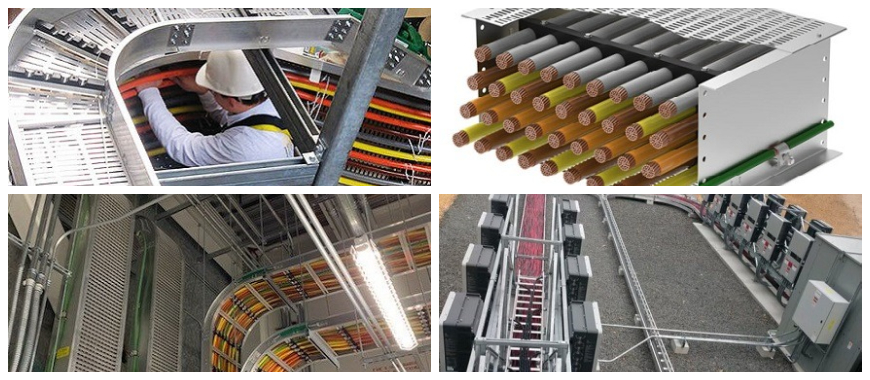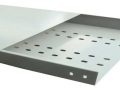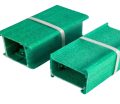
Installing cable trays in concrete slabs can present several challenges that may affect the long-term stability and safety of the installation. One of the most common issues is drilling into concrete, which can potentially damage underlying structures like electrical cables or pipes. This problem with installing concrete cable tray in concrete slabs requires careful planning and the use of accurate drilling techniques to avoid these risks. Additionally, choosing the right anchoring system is crucial. For instance, if the concrete is not strong enough or contains pre-tensioned cables, improper installation can lead to failure. Using the wrong anchors or fasteners can compromise the security of the trays. To overcome these problems, it’s important to consult as-built plans, use suitable fasteners, and consider alternative installation methods when necessary to maintain the integrity of the structure and the cables.
How About Solving the Problem Cable Tray in Concrete Slabs?
The installation of cable trays within concrete slabs is a common practice in modern construction, especially in industrial and commercial buildings. However, several challenges and problems can arise during installation, maintenance, or modification of cable trays in concrete slabs. These problems may affect the performance of the system, delay project timelines, or even lead to increased costs. Identifying these issues early on and understanding how to address them can make the difference between a smooth, efficient installation process and costly repairs down the line.
The Key of Common Problems with Cable Tray in Concrete Slabs
When a cable tray is integrated into concrete slabs, it can face various challenges that need to be resolved for the system to function properly. These issues can stem from improper design, poor installation practices, or environmental factors. Let’s explore the most common problems associated with cable trays in concrete slabs and the strategies that can help mitigate them.
- Improper Planning and Design
One of the most frequent problems related to installing a cable tray in concrete slabs arises during the planning and design phase. If the cable tray’s routing is not properly accounted for during the initial stages of construction, it may result in a misalignment with other systems or obstacles within the slab. For instance, the location of ductwork, plumbing, or other utilities could conflict with the intended path of the cable tray.
At GangLong Fiberglass, we always emphasize the importance of proper planning and accurate measurements when designing cable tray systems. Our team works closely with engineers and architects to ensure that the cable tray installation will not interfere with other infrastructure and will meet the necessary load-bearing requirements. It’s essential to plan the installation well in advance to avoid these kinds of issues.
- Incorrect Sizing of Cable Trays
Another common issue that arises is the incorrect sizing of the cable tray, which can lead to overloading or underutilization of the available space. A cable tray that is too small for the volume of cables it needs to support will eventually become overcrowded, leading to potential damage to the cables or the tray itself. On the other hand, using a cable tray that is too large could result in wasted space and unnecessary costs.
Choosing the correct size of cable tray is crucial. At GangLong Fiberglass, we offer a wide variety of cable trays, each designed to handle different load capacities and cable volumes. When planning the installation of a cable tray in concrete slabs, our products are engineered to ensure a perfect fit for your specific needs. The key is ensuring the cable tray can handle the expected load without causing overcrowding or excessive gaps that could impact the system’s overall efficiency.
- Installation Challenges and Errors
Installation errors are another significant cause of problems with cable trays in concrete slabs. These errors can range from poorly secured trays that shift over time to improperly installed supports that cannot bear the weight of the tray and its cables. Additionally, improper cutting of trays to fit within the slab or failure to securely fasten the tray to the concrete structure can lead to the tray becoming dislodged or damaged.
At GangLong Fiberglass, we understand the challenges of installing cable trays in concrete slabs. That’s why we provide detailed installation guidelines to ensure that every tray is properly fitted and secured. From the right choice of fasteners and support brackets to ensuring that the tray is correctly aligned and mounted, we take extra steps to guarantee that the installation is smooth and error-free. Proper installation also includes ensuring that the tray is level and aligned with other infrastructure, allowing for easier cable placement and future maintenance.
What Are the Issues Caused by Environmental Factors on Cable Tray in Concrete Slabs?
Environmental factors play a significant role in the longevity and performance of cable trays installed within concrete slabs. Over time, factors such as temperature fluctuations, moisture, and corrosive environments can lead to deterioration of both the concrete and the cable tray.
- Corrosion of Cable Tray Materials
One of the biggest concerns when installing a cable tray in concrete slabs is corrosion, especially in areas with high humidity or exposure to chemicals. Concrete, when improperly cured or exposed to moisture over time, can cause rust or other forms of corrosion in the metal cable trays. Corrosion not only weakens the structural integrity of the tray but can also damage the cables it is meant to protect.
GangLong Fiberglass offers a range of corrosion-resistant cable trays, ideal for installations in environments where moisture and other harsh conditions are a concern. Our fiberglass trays are designed to withstand the challenges posed by corrosive elements, offering a longer-lasting solution for cable management in concrete slabs.
- Moisture and Temperature Fluctuations
Temperature fluctuations can also cause issues with cable trays in concrete slabs. Extreme heat can lead to the expansion of materials, potentially causing stress on the tray or making it more prone to bending. Conversely, in colder environments, materials may contract, leading to gaps or misalignments that affect the overall integrity of the system. Moreover, moisture trapped in concrete slabs can exacerbate corrosion and potentially short-circuit electrical systems.
To mitigate the effects of moisture and temperature fluctuations, it is essential to choose the right materials for your cable tray. GangLong Fiberglass’s cable trays are designed to remain stable across a wide range of temperatures and environmental conditions, making them an excellent choice for areas where moisture or extreme weather is a concern.
How About the Solutions to the Problem Cable Tray in Concrete Slabs?
Addressing the problem of cable trays in concrete slabs involves a combination of thoughtful design, proper material selection, and careful installation. Fortunately, there are several practical solutions that can help resolve these issues effectively. Below are some of the solutions that can help ensure the durability and functionality of cable trays installed in concrete slabs.
- Use of Non-Metallic Cable Trays
In many cases, non-metallic cable trays, such as fiberglass trays, provide a better solution when dealing with environmental factors such as moisture and corrosion. Unlike traditional metal trays, fiberglass cable trays are non-corrosive and resistant to environmental stressors. This makes them ideal for installations in areas that are exposed to high moisture levels or other potentially damaging elements.
At GangLong Fiberglass, we offer a range of fiberglass cable trays that provide exceptional resistance to corrosion, making them ideal for use in concrete slabs. Our fiberglass trays are lightweight, durable, and easy to install, offering long-term performance without the concerns associated with metal trays.
- Installing Proper Drainage
Installing drainage systems in and around the concrete slab can help mitigate the risks associated with moisture buildup. Proper drainage prevents water from pooling around the cable tray and reduces the risk of corrosion and other moisture-related issues. This is especially important in environments where there is a risk of flooding or excess humidity.
GangLong Fiberglass also provides guidance on designing effective drainage solutions to protect cable trays. Our team works with engineers to incorporate proper drainage during the installation of cable trays in concrete slabs, helping to ensure that your system remains intact and functional for many years.
- Regular Maintenance and Inspection
Routine maintenance and inspection are key to identifying and addressing any issues before they become significant problems. Regularly checking the condition of the cable tray, ensuring that it remains securely mounted, and verifying that no corrosion or damage has occurred will help extend the lifespan of the system.
GangLong Fiberglass recommends regular inspections as part of an overall maintenance plan for cable trays in concrete slabs. Our products are designed with ease of inspection in mind, allowing you to quickly assess the condition of your system and address any issues promptly.
The Key of Future-Proofing Cable Tray Systems in Concrete Slabs
To avoid future problems with cable trays in concrete slabs, it’s important to future-proof the installation. By considering the potential for expansion, additional cable management needs, and environmental changes, you can ensure that your system remains efficient and adaptable. Proper planning, material selection, and ongoing maintenance are crucial in maintaining a cable tray system that will perform well for years to come. At GangLong Fiberglass, we provide high-quality, customizable cable trays that can be tailored to meet the evolving needs of your infrastructure.
How to Choose the Right Cable and Hose Trays
What Are the Common Problems with Problem Cable Tray in Concrete Slabs
Installing a cable tray in concrete slabs is an essential part of modern construction. It helps in organizing and securing electrical wiring. However, there are several problems that can arise with the cable tray in concrete slabs over time. These issues can affect both the functionality of the cable tray and the integrity of the concrete slab itself. Identifying and addressing these issues early can prevent long-term damage, ensuring safety and durability. Managing the problem cable tray in concrete slabs is key to maintaining a properly functioning electrical system.
The Key of Identifying and Addressing Problems with Problem Cable Tray in Concrete Slabs During Installation
Proper installation is critical to avoid the problem cable tray in concrete slabs. Misalignment, improper anchoring, and incorrect placement during installation are common issues that can lead to misalignment or shifting of the tray. This can result in uneven cable distribution, structural stress, and potential damage to the cables. If not addressed early, these installation errors could create problems in the future, requiring costly repairs.
At GangLong Fiberglass, we focus on providing easy-to-follow installation guides for our cable trays. By ensuring that the tray is properly aligned and securely anchored during installation, you can prevent the problem cable tray in concrete slabs caused by installation mistakes.
The Impact of Overloading the Problem Cable Tray in Concrete Slabs
Overloading the problem cable tray in concrete slabs is a major issue that can result in significant damage over time. If the cable tray is overloaded with too many cables, it can cause the tray to warp, bend, or break. This not only leads to physical damage but also creates hazards such as overheating of cables or potential fire risks. Additionally, overloading the tray may place excessive stress on the concrete slab, causing cracks or weakening the overall structure.
How Innerduct in Cable Tray Enhances Cable Organization
How the Problem Cable Tray in Concrete Slabs Can Lead to Corrosion and Material Degradation
Corrosion is another problem that can affect the cable tray in concrete slabs, especially if the tray is exposed to moisture or chemicals. Over time, corrosion can weaken the material of the tray, causing it to lose its structural integrity. If left unchecked, corrosion can lead to the failure of the tray, which could result in damaged cables, electrical faults, and even fire hazards. This issue is particularly concerning for trays that are installed in areas where moisture levels are high or in environments with aggressive chemicals.
At GangLong Fiberglass, our cable trays are made with high-quality, corrosion-resistant materials to reduce the risk of corrosion. We recommend using our fiberglass cable trays for environments where corrosion is a concern, as they are designed to withstand challenging conditions and prevent the problem cable tray in concrete slabs from deteriorating prematurely.
What Are the Risks of Poor Maintenance of the Problem Cable Tray in Concrete Slabs?
Failing to maintain the cable tray in concrete slabs can lead to a host of problems. Over time, dust, debris, and dirt can accumulate on the tray, obstructing airflow and reducing the effectiveness of the system. Additionally, cables can become worn or damaged if they are not properly supported, which may lead to electrical faults or even system failures. Without regular maintenance and inspections, small issues can escalate into larger problems with the cable tray in concrete slabs, causing costly repairs or replacements.
Routine inspection and maintenance are essential to prevent the problem cable tray in concrete slabs from becoming a major issue. GangLong Fiberglass recommends setting up a regular maintenance schedule to ensure that your cable tray system remains clean, secure, and in good working condition over time.
The Key of Preventing Issues with Problem Cable Tray in Concrete Slabs
The best way to prevent the problem cable tray in concrete slabs is by addressing the issues before they arise. Proper planning, correct material selection, and accurate installation can prevent many of the common problems associated with cable trays. Furthermore, regular maintenance and monitoring ensure that any issues can be identified and corrected early, avoiding more serious complications down the line.
GangLong Fiberglass provides a wide selection of cable trays designed to meet various project requirements. Our trays are engineered to reduce common issues such as overloading, corrosion, and misalignment, minimizing the risk of the problem cable tray in concrete slabs. By selecting the right system and taking preventive measures, you can ensure the longevity and safety of your cable tray installation.
Best Practices for Cable Tray Risk Assessment During Installation
FAQs about Problem Cable Tray in Concrete Slabs
Basket trays, although widely used for cable management, have a few disadvantages that may impact their suitability for certain applications. One of the main drawbacks is their limited capacity to support larger or heavier cables. Since basket trays are typically made of wire or mesh, they may not provide the same level of support as solid-bottom cable trays, which can be necessary when dealing with high-weight or high-power cables. Additionally, basket trays have an open design, which means that cables are more exposed to dust, debris, and physical damage. In environments where cables need extra protection from external elements, a different type of tray, such as solid bottom or ventilated trays, may be a better choice. Furthermore, basket trays are not always ideal for installations in areas with strict safety or fire regulations, as the open construction may not offer the same level of fire resistance as some other tray types. While they are cost-effective and offer good flexibility, these factors should be considered when deciding whether to use basket trays.
Concrete can potentially damage cables if proper precautions are not taken during installation. Direct contact between cables and wet or uncured concrete can cause insulation breakdown or corrosion. Concrete is highly alkaline, and when it comes into contact with certain types of cable insulation or metallic conductors, it can lead to degradation over time. Furthermore, the moisture and chemical compounds present in fresh concrete may be absorbed by cables, resulting in long-term damage. To prevent such issues, it is important to use protective conduits or coatings around cables when installing them in areas where they may come into contact with concrete. Additionally, cable trays or raceways should be used to elevate cables off the concrete surface, providing an extra layer of protection. Proper sealing of cables in waterproof enclosures or using corrosion-resistant materials for installation can also help mitigate any potential damage from concrete exposure. By following these practices, you can significantly reduce the risk of damage and extend the lifespan of your cable systems.
Yes, cable trays need to be properly bonded to ensure safe and reliable electrical installations. Bonding refers to the practice of connecting all metallic components of the cable tray system to a ground or earth, which helps prevent the buildup of electrical charges that could lead to shock hazards, short circuits, or fire risks. According to the National Electrical Code (NEC), cable trays that support electrical wiring should be bonded to ensure they are electrically continuous and properly grounded. This is especially important in environments where the tray will be exposed to electrical faults or where sensitive equipment may be in use. Bonding also improves the overall safety of the installation by providing a low-resistance path for fault currents, which can help protect both personnel and equipment. It’s essential to use appropriate bonding materials, such as bonding jumpers or ground conductors, and to follow the relevant installation guidelines to ensure that the cable tray system is properly grounded and safe to use.

As the editor of GangLong Fiberglass, I have years of experience and in-depth research, focusing on cable tray products, fiberglass solutions, and grille systems. I incorporate years of industry insights and practical experience into every content, committed to promoting the progress of the industry. At GangLong Fiberglass, my commitment is reflected in every product, from innovative cable trays to durable fiberglass solutions and sturdy grille systems. As an authoritative voice in the industry, my goal is to provide valuable information to professionals and businesses and promote forward-looking solutions.


